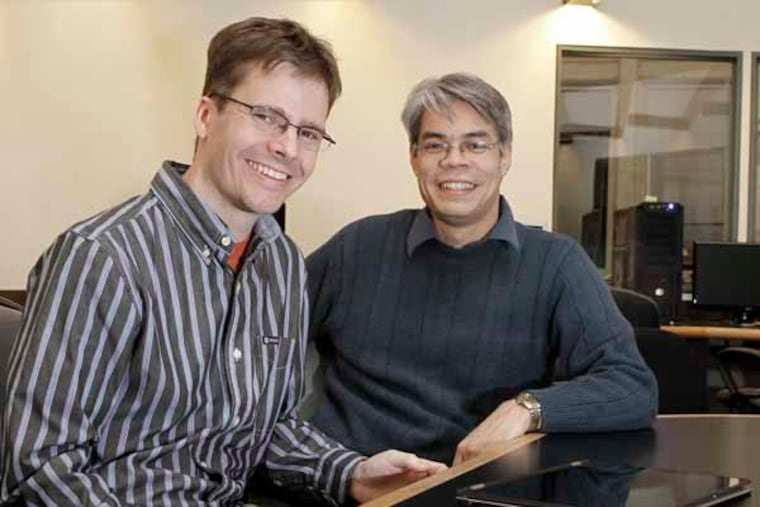Bioelectronics conference takes an interdisciplinary approach to medicine
What if . . . The tiniest electrical device, wrapped around a nerve, could signal the cells lining your stomach that it is full, thereby quashing your desire to eat everything on the left side of the refrigerator? Or tell the dormant pancreas of a diabetic to resume making insulin? Or tell the muscles around a senior's bladder to contract like they used to so nothing leaks? Or tell the fibers in the lungs of an asthmatic child to relax so breathing is easy?

What if . . .
The tiniest electrical device, wrapped around a nerve, could signal the cells lining your stomach that it is full, thereby quashing your desire to eat everything on the left side of the refrigerator? Or tell the dormant pancreas of a diabetic to resume making insulin? Or tell the muscles around a senior's bladder to contract like they used to so nothing leaks? Or tell the fibers in the lungs of an asthmatic child to relax so breathing is easy?
Those types of questions were thrown about last week in New York, where drugmaker GlaxoSmithKline gathered 150 or so scientists from many disciplines, some not commonly associated with medicine, to devise a challenge worthy of a $1 million prize: "Create an implantable wireless device that can record, stimulate, and block neural signals to a single organ."
Bioelectronics, as the field is often called, is not new. But big pharmaceutical companies are not creating blockbuster drugs anymore, so their profits are under pressure. Under chief executive officer Andrew Witty, GSK is shaking up many parts of its business, research included.
Besides the $1 million contest, GSK has doled out bioelectronics research grants, including to the University of Pennsylvania.
"With older medicines, we engaged with human biology through structures - molecules - and we speak the language of those structures when we create medicine," said GSK research chief Moncef Slaoui, who splits his time between headquarters in London and company facilities in Philadelphia and Upper Providence.
"When we started asking questions about our business model three years ago, we asked how sustainable it was to continue discovering medicine that way, knowing we have to create medicine that is distinctly better, otherwise payers won't pay for it."
Wilson Greatbatch is a bioelectronics legend. He was an electrical engineer who liked to tinker in the barn beside his home near Buffalo, but he also learned bits of biology while at Cornell University. Helped by William Chardack, chief of surgery at a local veterans' hospital, Greatbatch invented the first self-contained cardiac pacemaker to be surgically implanted in humans, helping to steady their irregular heartbeats.
That was in 1960. In 1961, Greatbatch and Chardack licensed the invention to a young and struggling Minnesota company called Medtronic. In the fiscal year ended June 30, Medtronic's cardiac rhythm management division had $4.9 billion in sales. The American Heart Association estimates 600,000 pacemakers are implanted each year.
"The pacemaker was a revolutionary device," Slaoui said. "In 10 or 15 years, I think we will have much more intelligent devices."
Smart people hoping to deliver better health care at lower cost have argued for applying the knowledge of nonmedical people, including systems engineers and statisticians, to hospitals and other health-care settings.
Slaoui and others say that approach will be needed to overcome daunting challenges to deliver better care within a single patient. Hypothetically, nerve impulses from the brain might be 90 percent alike but 10 percent different in the "language" they speak with particular organs. Can scientists and devices decipher and translate that language properly to achieve the desired result internally - and transmit the information out of the body to researchers to prove the concept and then, perhaps, to a patient's cellphone for self-monitoring?
In 2009, the semiconductor electronics division at the U.S. Commerce Department's National Institute of Standards and Technology published a study, "A Framework for Bioelectronics: Discovery and Innovation."
The study said key challenges included the need for the device to function with materials that do not alter (much less kill) healthy molecules, avoid overheating tissue when power is transmitted, and to do it all at an affordable price.
Brian Litt directs Penn's Litt Laboratory, which does neuroengineering research, often with epilepsy patients. A big part of his lab's work involves bioinformatics, using computers to analyze huge data sets of biological information. A $40,000 grant from GSK will go toward crunching data related to "detection of disease signatures in neural signaling patterns," according to GSK.
Litt, whose lab also gets research funding from Medtronic, credited GSK with "trolling" to get an "incredible array" of investigators to the meeting to discuss "how peripheral nerves interface with the body to cause, control, and treat disease."
GSK and Penn worked out intellectual property rights on the grant. But Slaoui insisted GSK won't have proprietary rights to the device that wins the $1 million prize, though he hopes GSK becomes "a preferred partner of choice."
Pay models are also being reexamined. Slaoui said one idea was to have patients or their insurers pay a monthly fee for the device as long as the patients stay healthy. But Slaoui is agnostic about what body part or disease should be researched first.
"You might say that treating obesity and diabetes is best for public health, but maybe that's not the first thing that works, maybe it is the bladder," Slaoui said. "We intend the decision to be guided by the science."
215-854-4506
@phillypharma